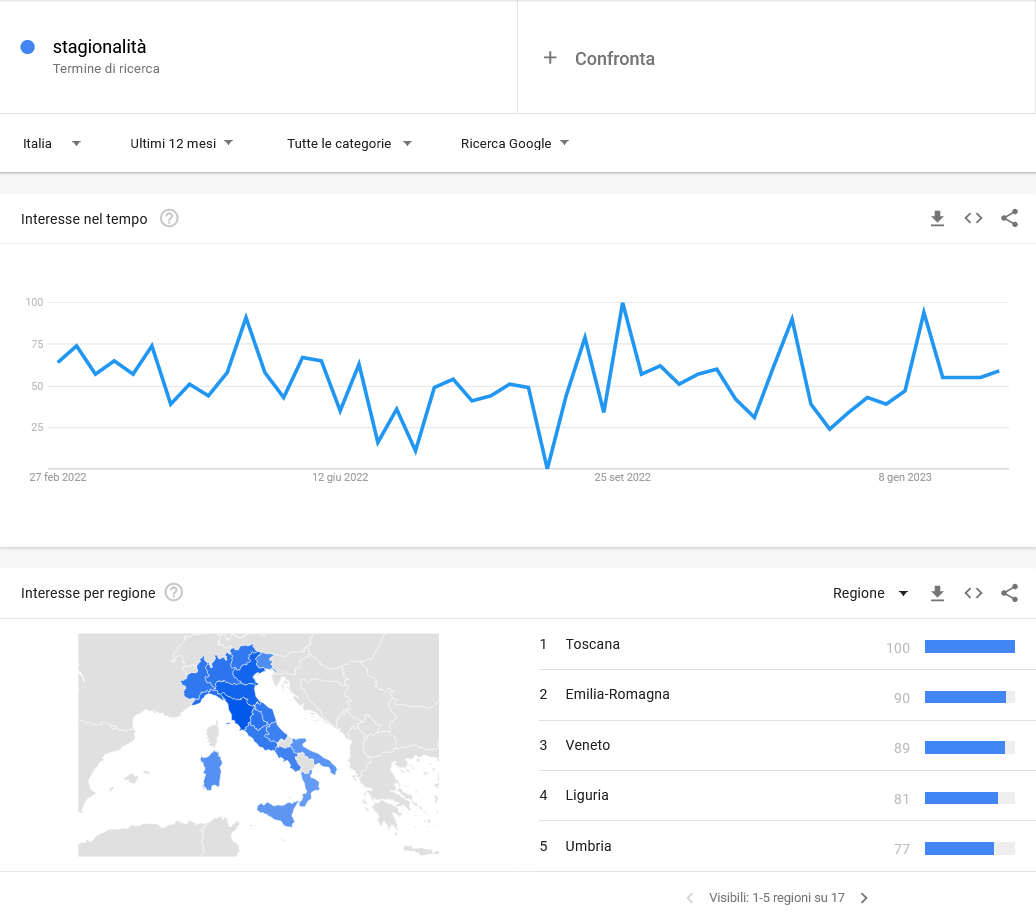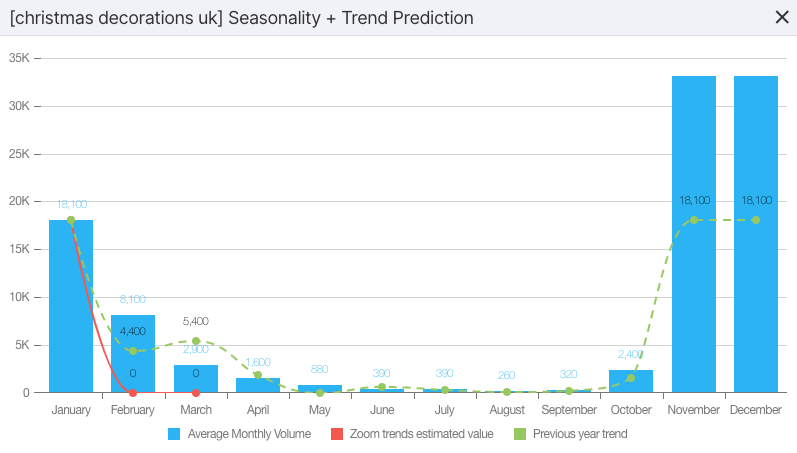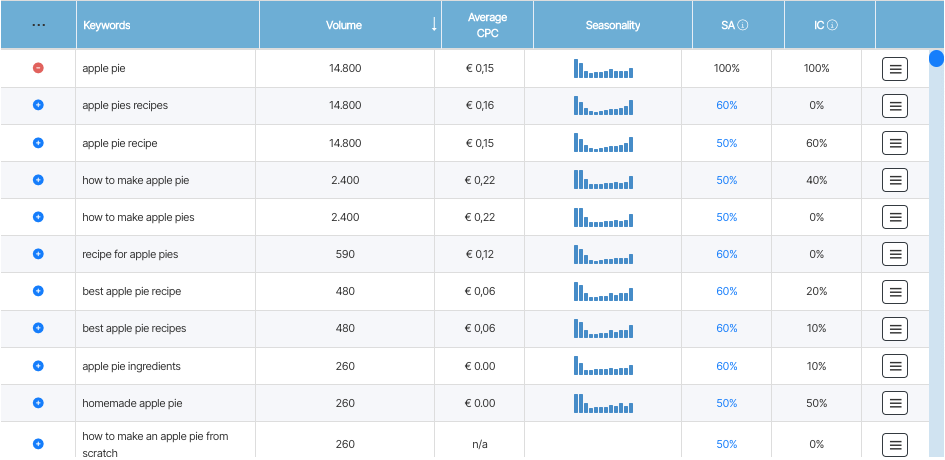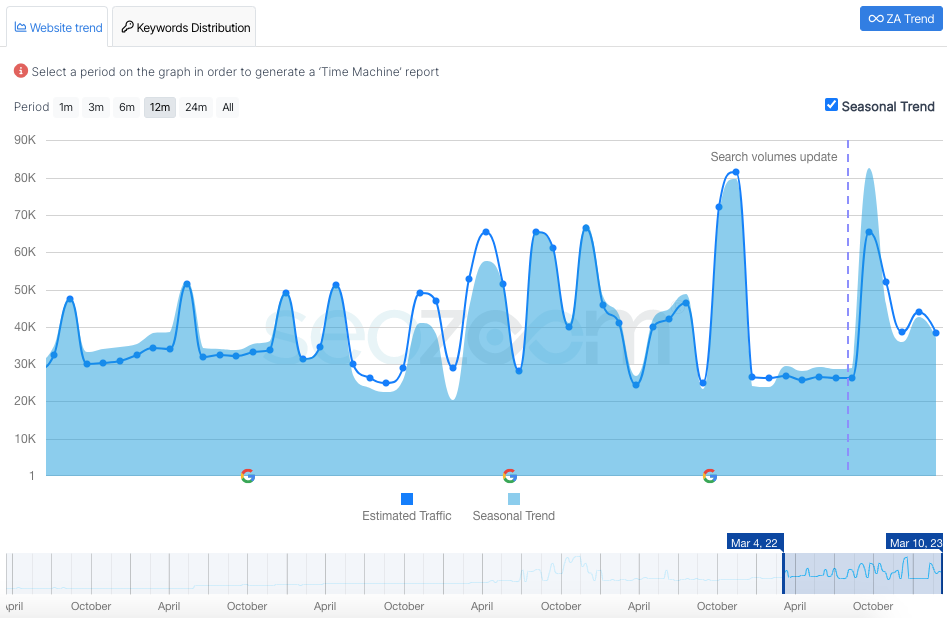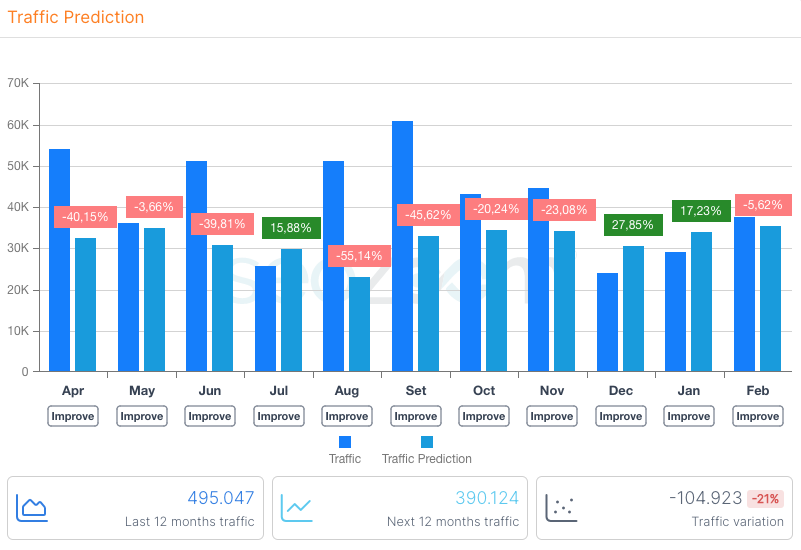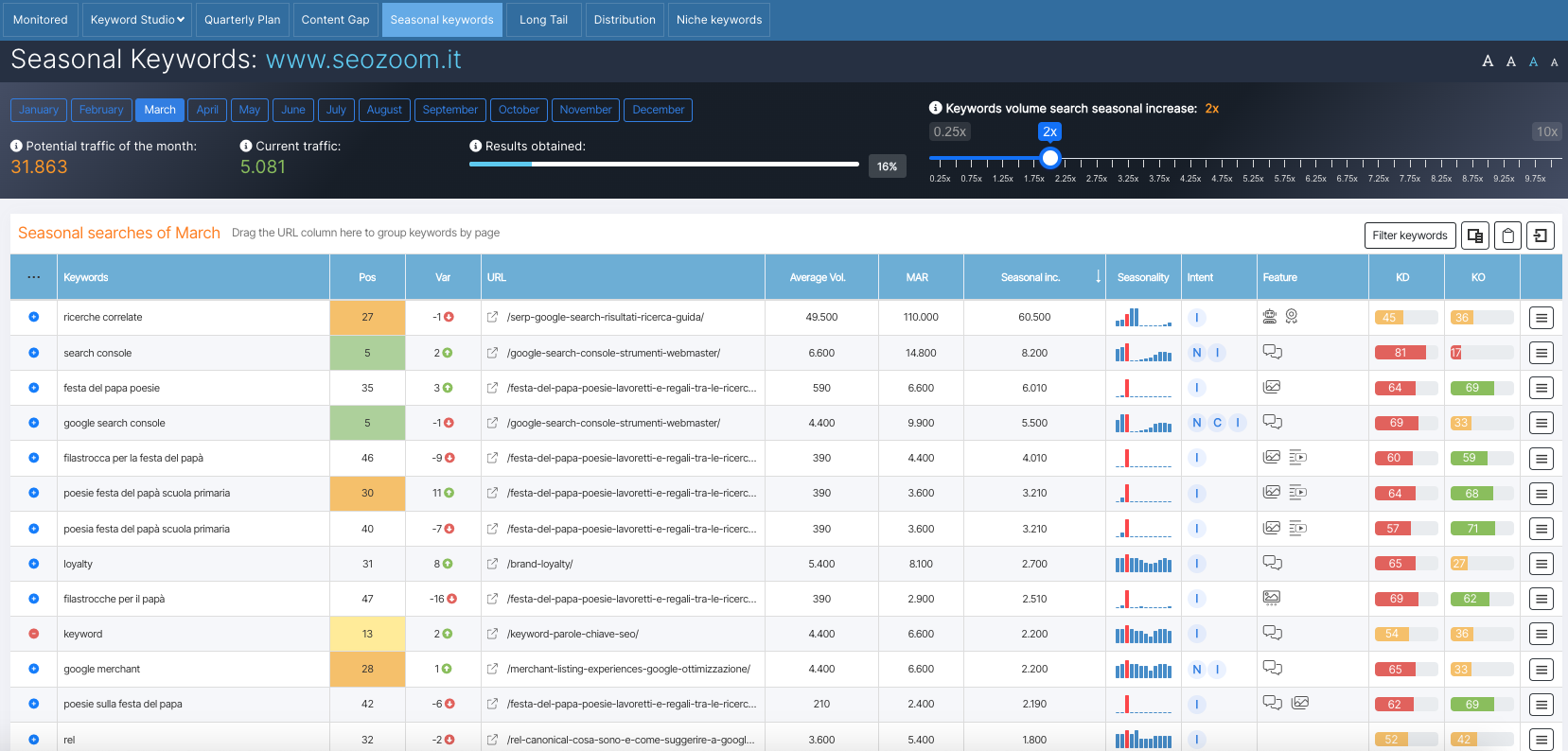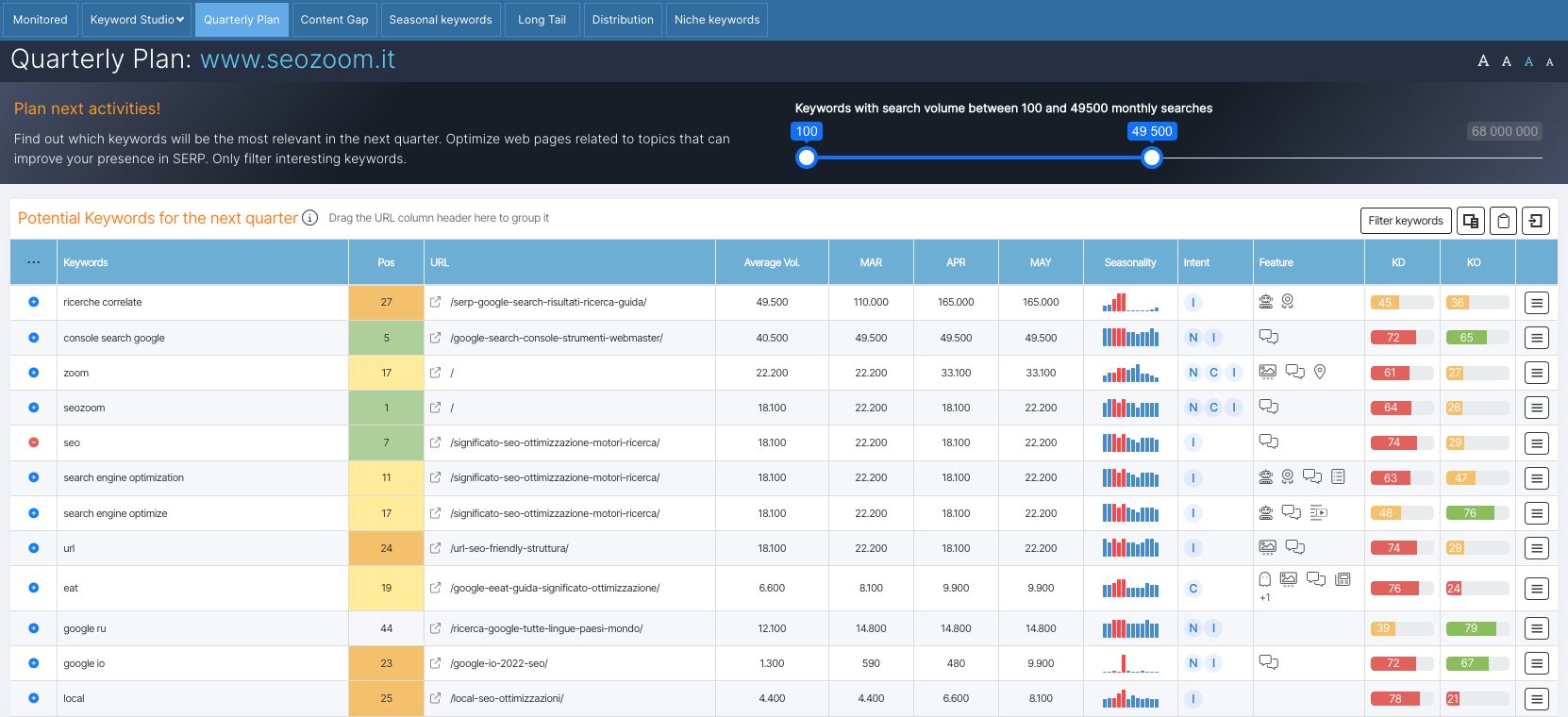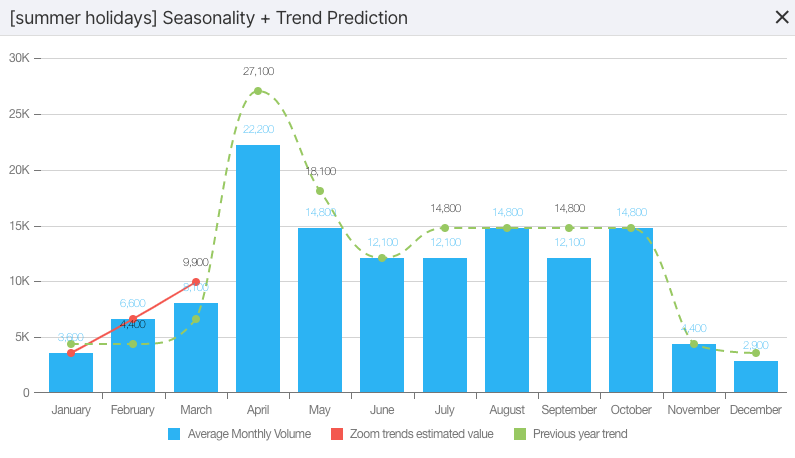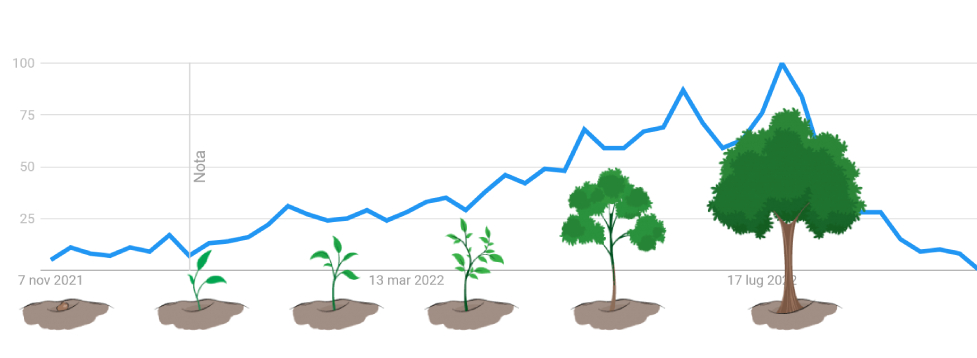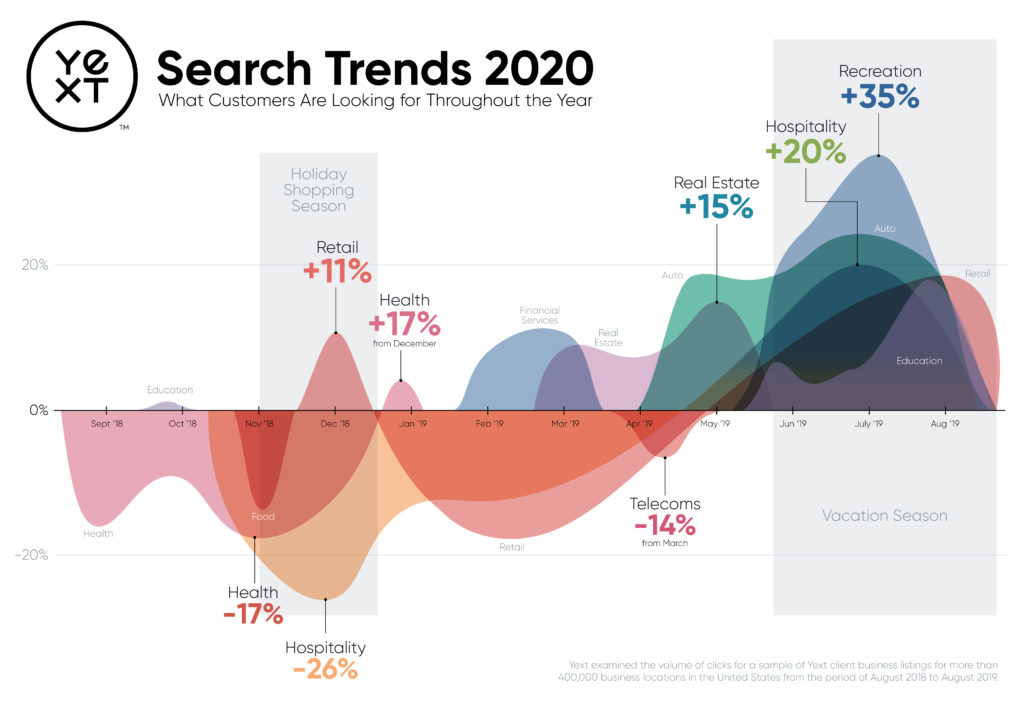Anticipate search trends and competitors with SEOZoom
The time factor is crucial in any kind of business, and SEO is no exception: knowing when to publish content is a crucial aspect of increasing the chances of getting the desired results, and thanks to a number of tools we can understand the seasonality of searches to appropriately anticipate trends and stay one step ahead of competitors to intercept people “at the right time.” So let’s take a deep dive into the value of seasonality for SEO and keywords, to understand how SERPs change throughout the year and how much this impacts actual user searches.
What is seasonality for SEO
It is called seasonal SEO and is considered a branch of traditional SEO.
It involves approaching optimization activities with the same basic strategies, but looking at varying search trends over the months and the seasonal popularity of different products or services, in order to generate conversions at the appropriate time by anticipating the flows of users interested in those needs.
To maximize results and efforts, we need to monitor all these factors to identify the right keywords to use and, most importantly, the best time to publish or refresh content, with the goal of gaining ranking advantages and providing people with useful content at the time when they really need it.
At first glance, we might think that seasonality does not affect all business models and is of interest only to e-commerce or at most news sites: in fact, if we look closely virtually all keywords undergo more or less regular fluctuations throughout the year, with people’s interest starting to slow down when attention is placed elsewhere. When this happens, so do Google SERPs, which always try to adapt quickly and proactively to changes in user search frequency and search intent.
Broadly speaking, we can recognize two main types of keyword seasonality strategies:
- Time-based: seasonality in the “purest” sense, which analyzes and focuses on the seasons of the year (such as summer or winter) or on a specific time frame, such as a month or a quarter.
- Event-based: analysis focuses on specific events that occur cyclically and move people’s interest, both in terms of information seeking and purchasing. Examples of events are Christmas, Black Friday, Halloween, Valentine’s Day, but also the Oscars, political elections, or, as we will see, summer holidays.
Understanding and anticipating how SERPs will change during these seasonal periods and events helps us implement more informed and conscious SEO strategies to preside over searches and maintain online brand visibility.
Why seasonal SEO is important for a brand
Seasonal SEO is thus how a website’s performance and activity is affected by predictable and recurring external annual events, such as Christmas, Easter, summer, winter, and so on.
A solid understanding of keyword seasonality is essential for building a winning SEO strategy, gaining insights from performance data, and eventually providing accurate reports to clients.
If we think about an ecommerce business, for example, this information is crucial in helping the site and the business increase conversions: in a simplified way, marketing products or services at the time when people really need them allows us to increase sales (or at least the chances of sales) and can open up new revenue streams for the business, which balance out the months when product sales are inevitably low.
As the seasons change, in fact, so do the interests and products purchased by the public: some items may be needed year-round, but others fluctuate in popularity depending on seasonality (to give a few quick examples, Christmas decorations, Easter eggs, calendars, and so on are all products with strong seasonality), and therefore working on seasonal SEO allows us to know when people are most likely to search for what we have to offer and, if we work well and on time, reach them with useful content.
Understanding the seasonality of keywords and SEO is in summary important because:
- It serves to benefit our business.
- It helps us plan and decide what SEO projects to run, what content to work on, and when.
- It helps us navigate marketing in the “off-season.”
- It can influence SEO metrics such as clicks, impressions and ranking.
Understanding seasonality means controlling the weather
Understanding keyword seasonality means controlling the weather, or at the very least it helps us predict the mutations that occur throughout the year and years to implement the appropriate strategies. In fact, as we were already saying when talking about evergreen content, in every industry there are recurring topics that are only searched for at specific times of the year, and carefully following all the trends in our industry can allow us to get the most traffic available month by month.
We reiterate this even if it sounds trite: users search for certain topics only (or predominantly) at certain times and months of the year, and this is true even for seemingly evergreen topics, so understanding seasonality allows us to improve our performance and work in advance to devise an appropriate strategy to seize the moment and attract audiences at the right time.
Seasonal topics and keywords are topics, objects, holidays that recur in specific months and can arouse interest in the audience for longer or shorter periods, but always recurring year after year: thanks to various tools, and in particular SEOZoom, we can know a priori how many people will search the search engines for information about them, when they will start doing so, and for how long they will do it. During certain periods, months or at particular events and, indeed, anniversaries, it is easy to notice increases or collapses in interest in certain keywords, which translate into increases or decreases in visits to the site positioned for those keywords.
It follows that those who know their industry, and their website, perfectly are able to anticipate and understand exactly what might happen and when, so as not to be displaced and indeed to move ahead of competitors to intercept the new flow.
How seasonality affects SERPs
Seasonality impacts SEO because it also affects Google SERPs, which as we know adapt (among other factors) to so-called freshness, basically reacting to a changed or growing interest of people.
We have said it so many times: the ultimate goal of Google is to provide a high-quality SERP that meets the needs of users by responding to a query with the presentation of high-quality results. For this, Google determines whether a query requires a seasonal or temporary change that is more effective, beneficial, and useful to people at that time, and according to this Search Engine Land article it might consider among other things:
- Increases in searches for the query, comparing period Y with X.
- Changes in user SERP behavior for the query, such as changes in click patterns, scrolling, pogo sticking effect.
- Increase in users performing additional queries to refine the search.
- Changes in additional terms or stop words introduced in the next query.
If Google detects changes in these user patterns, it may choose to start experimenting with the SERP and vary the results and resource types, or even introduce new SERP resource types and features, as we already explained when discussing search journey applied to the search engine.
Over time, Google will understand such patterns and refine SERP adjustments to remain effective.
For those who work in search marketing, knowing seasonality means having a predictive or rather predictable data base that we can use to plan marketing activities, content, and onpage resources, with an additional step being to assess how the SERPs will change during these seasonal periods, so as to properly inform our SEO strategies by going about determining the most appropriate type of content and publication timing.
How to analyze seasonal trends
At this point, having clarified the reasons why it is useful to understand seasonality, we need to find the right tools to get the information we need: before we focus on SEOZoom’s little gems (forgive us for our lack of modesty!), however, we will see what Google makes available to us.
- Google Trends
Google Trends is definitely a great way to see the change in keyword search flows and behaviors over time, and the graphs give us at a glance an understanding of when historically a product, service or topic is most searched for to identify the best time to attack the market and SERPs.
In the food sector, seasonal trends are very evident: for example, watermelon is more popular during the summer, while pumpkins are more searched for during the fall: with Google Trends we can see these different fluctuations in product popularity and, at the same time, get an idea of how people search for different terms over time, even refining our investigations with the appropriate filters (selecting a time period, specific locations and cities or type of intent). The limitation of this tool is that it only offers statistical and probabilistic estimation and not “substantive” data, but still it can help us identify the right time to boost our content.
- Google Keyword Planner
The Keyword Planner is a built-in feature of Google Ads that serves to find relevant terms for ads: by entering a keyword in this tool, we can discover a list of related keywords to consider and also interest in search terms, which help us to see how it changes over time and also identify the periods and times when those terms are most likely to be searched.
- Google Search Console
As we work on our pages, we can use Google Search Console reports to discover and monitor trends in visits and interactions on the pages year by year-with accompanying data on clicks, impressions, location, devices, and more-so that we can attempt to identify trends on the site. The disadvantage is that there is no predictive data or information and, therefore, we can at best prepare a strategy based on old trends, but at any rate it helps us get useful insights to target strategies in the wake of the temporal popularity of keywords.
SEOZoom’s tools to analyze seasonality
From an SEO perspective, the seasonality of keywords and topics in a site’s content is one of the possible causes of declines in organic traffic, because page rankings are subject to time-related changes in traffic volumes.
It should be clear at this point, for example, that if we analyze the traffic of a site that deals with the sale of Christmas products, the volume of searches will gradually begin to increase around October and surge upward in November; thereafter, the traffic will peak in December, begin to decline from January and then reach the minimum volume of traffic in the summer months.
To keep an eye on all these factors, SEOZoom provides a number of tools for analyzing the seasonal trend, found in single keyword analysis, domain analysis, and, more in-depth, project-based monitoring: all of which concur to inform us whether the expected traffic undergoes major changes at specific times of the year and when, offering support in evaluations of the timing of content publication.
Compared to other SEO tools, then, SEOZoom uses an innovative algorithm that provides accurate information about search volumes in real time: it is called “Trend Prediction” (formerly Covid-19 Impact) and is already integrated within the seasonality graph in keyword analysis. In technical terms, this algorithm is able to project the interest shown in the previous 12 months onto today’s real-world scenario using search trends and allows everyone to have clear insights, based on real data, to understand what is happening to searches in actuality, and not on the canonical (and sometimes outdated) historical search volumes.
- Seasonality in Analyze Keyword
Launching an analysis of any keyword, we can immediately see if it is a keyword subject to seasonal variations: from the very first answer box, in fact, SEOZoom indicates the classic data related to the average monthly search volume but also (in brackets) the range of variation related to seasonality, precisely, in the form of minimum and maximum value that the volume can reach according to the various periods of the year.
This rough information is deepened in the next graph, which shows the historical monthly variation of the search volume of the keyword analyzed and also reports, with different color graphs, the previous year’s trend and the value estimated by Zoom Trends, which we need to know what the current search trend really is. By clicking on Show Trend we can investigate the trend analysis more deeply, activating a pop-up graph that shows us the detail of the search volume in the average year, again with the graphical representation of the estimated volumes in real time.
In addition, in all keyword tables there is a column dedicated to the monthly representation of seasonality, which allows us to quickly obtain information on the change in the trend of searches.
- Seasonality in Analyze Domain
By investigating a website in its entirety, however, we can find out right away whether its estimated traffic deviates from or is in line with the seasonality trend: just click on “Seasonal Trend” within the domain trend graph and check the two different value curves, which represent the search volume actually achieved by the site (the blue line) and that predicted by seasonality (represented by the curve filled in blue) for each keyword.
In this way, the graph is more reliable and closer to the real performance of the website according to seasonality, to understand whether the performance of the website with the volume of searches is related to time factors (drop in Google searches, in line with the blue graph) or whether it depends on other causes. As a rule, the traffic trend should be in line with that of the seasonal trend: if we notice that the seasonal trend line surges in a given period while the traffic declines, we can assume that the site is experiencing some kind of problem and it would be advisable to take corrective action by conducting in-depth analysis to identify the reason for the decline.
- The chart on traffic prediction (Project)
Already in the first project dashboard, we can study the Traffic Prediction box, which indicates the “expected traffic” that may reach the site in the next 12 months: an estimate based on current placement data and seasonality of individual months, assuming that for the next 12 months the estimated data will remain the same.
- Seasonal Keywords (Project)
Still in the project area, there is a specific section for analyzing seasonal trends: it is simply called “Seasonal Keywords” and offers a complete report on the seasonal volumes of the keywords for which the project-entered website is positioned. From the horizontal selector at the top we can choose the month to be analyzed and thus see in the central table a list of all the keywords that in that month have an increase of at least 0.25 percent over the average annual volume.
Even at first glance, the tool gives us four aggregate figures:
- Potential traffic of the month: the estimated traffic assuming that the keywords listed in the table (and not on the first page on Google) reach the fifth position in SERP.
- Current traffic: the current estimated traffic, based on the seasonal keywords already ranked in TOP10.
- Results obtained: a horizontal bar showing at a glance the current percentage of traffic of seasonal keywords on the project site compared to the total potential they could achieve.
- Increase: a selector that allows, by increasing or decreasing the value on the scale, to filter out keywords with increasing seasonal variation.
All of this information allows us to get an overview of the website’s progress and potential and to plan page reviews, to develop our content creation or link building strategies.
- The Quarterly Content Plan (Project)
The Quarterly Plan tool, also present within the Project-based monitoring, allows us to perform an analysis on the upcoming quarter, to find out which keywords will tend to be more relevant and thus prepare an appropriate optimization strategy to improve our presence in SERPs.
With the filter in the upper right corner, we can select keywords based on a specific range of search volume, so that we can work more directly and strategically on a smaller group of keywords and pages.
How to optimize content for seasonal trends
After finding the data, we need to apply them to our strategies: the most immediate tool for intercepting trends is content creation, which is the lever by which our site and our company can gain valuable leads and conversions by directing interested traffic to our pages.
In order to capture these interested users, it is precisely crucial to work on search intent (a key factor for all content) and seasonal trends, trying to stay in line with what is relevant to people during that specific season (or the next one, since ideally all of this activity must be planned and executed in advance to be effective).
An example of a seasonal keyword: the trend of summer holidays
To understand how to concretely apply data and insights to content, we can hypothesize working on the keyword seaside vacations, which is subject to strong seasonality.
Picking up on the simile used in the image (based on the resource found on cleanpng), we can think of the seasonality curve as the growth of a tree: the seed is planted, i.e., interest begins to rise, in October, both for those who start planning trips for the following summer and for those who manage to organize a winter trip to exotic destinations; the plant reaches its peak around April, and then decreases. This is already a relevant and not obvious information: people start looking for possible summer locations where to go on vacation so early, since by the time August actually comes around people have already booked something to do or actually performs different searches, and therefore at different times of the year they change users and search intent.
In addition, deepening with our predictive algorithms – zoom trends and previous year trends – also reveals to us that historical values deviate, albeit not significantly, from actual and current values.
If we want to drive traffic with our content, we need to make sure that we are absolutely positioned at the right time, but anticipating the work to achieve this. So, if the growth of the search trend is between April and May (the time when our page MUST be visible on Google), it is in the previous quarter that we need to start working on content and site optimization, such as giving that content the right visibility, bringing it within a few clicks of the home page and into the categories it belongs when useful.
In this way, we also communicate to Google the relevance of that content with the site structure and internal links. Strategy also means this: awareness of the industry and context, the users and also the content on our website, which then allows us to know what might happen and when (working to anticipate seasonal trends)
If we can set the right strategy we can:
- Create better and more useful responses, more to focus on user intent.
- Close any content gaps and provide answers where they are missing.
- Be “in the piece” and leverage the time factor.
- Increase visits day by day.
- Get maximum results from each and every visit, because we have targeted the right user who finds the web page that delivers quality content.
In other words, we can achieve the most desired goal of any site: to do the right traffic, for the right users, at the right time, while also studying the funnel to intercept the person’s need in the most appropriate way, serving the most appropriate response.
Interaction and seasonality for business sites, study of trends in the U.S.
Still on the topic of practical applications of seasonality information to daily business, we can refer to an interesting report conducted some time ago by Yext, a U.S. company operating in online brand management, which analyzes the relationship between consumers and business sites, with useful insights for those working on SEO optimization of business projects.
The study reveals that consumers are becoming more interactive with search results related to business sites, but it also addresses the significant impact of time trends on clicks and interactions.
Business sites and clicks, a study about trends in the United States
The investigation has been made by Yext, an american company working on the online brand management field, and reveals that consumers are turning more and more interactive with the search results correlated to business sites, as we already said in the article about the impact of the Google’s SERP features on users’ habits.
The three most interesting points of the study
The data gathered by the study carried out on a sample of over 400.000 business SERPs in the US draw out three main elements:
- Consumers are gettin more and more active in search: Consumer actions in business listings grew of the 17% over the past year, like with driving directions clicks, clicks to call businesses, and more.
- Research and researchers are getting better: over the past year, consumer actions grew faster than search impressions of business listings (10%), suggesting that customers are finding what they want faster. So customers are spending less time searching and more time engaging with businesses, and this can depend both on the ever growing people’s familiarity with Google Research and their use of more specific queries, or on the better ability of search engines to understand said queries.
- Reviews are on the rise: Consumers are leaving more feedbacks about businesses. Review count per business location grew 27% over the year, and especially financial services review volume grew 91% per location, the fastest growth of any other industry. Businesses are getting savvier about the importance of reviews as well, responding to reviews 47% more than the previous year, and the higher probability of being read and answered can encourage people to write.
Understanding seasonality to enhance performances
Alongside the current picture of the business sites’ situation, Yext also tried to outline the main trends expected on 2020; as Zahid Zakaria says, the company’s Senior Director of Insights and Analytics, “Some industries are naturally more popular with consumers during certain seasons, but the need for businesses in every category to be in control of their facts online stays important year-round”.
What still is fundamental is “to capture the wave of customers who are interested in transacting with them, no matter what month it is”, and in this perspective businesses should be ready “by ensuring their information is accurate across channels, from the search results on their own website to their listings on third-party platforms”.
Seasonality calendar in the United States
Here then follows the calendar of seasonality trends for business sites in the US (the image above is taken from yext.com site):
- January: watch your health. With New Year’s resolutions fresh on their minds and cold and flu season at its peak, americans start the year off with visits to the doctor; in January, healthcare organizations see a 17% increase in clicks compared to the previous month.
- February: watch your wallet. In February and March tax season is well underway: consumers engage with financial services institutions up to 11% more than the annual average.
- March: open house. Spring time is a period of renewal for homes as well: real estate agency ads for house hunting and selling see a 22% average increase from February to May.
- April: the end of the phone bubble. The wave started in the winter of consumers picking up the latest high-profile smartphone upgrades from the fall has subsided: clicks to phone carrier and telecommunications provider listings in search drop 14% compared to the month before.
- May: engines on full throttle. Consumers look to capitalize on Memorial Day sales and revamp their rides in time for summer : clicks to automotive service search listings increase 18% compared to the annual average.
- June – July: time for some fun. Over the summer months users think about outdoor recreational activities: results for recreation and entertainment listings online, including theaters, sports venues, nightlife, and more, see an increase of 35% relative to the annual average. Clicks to hotel listings also bump up to 20% above the annual average during this time due to summer travel.
- August: back to school. School is just around the corner and parents and students are not just stocking up on clothes, school supplies, gadgets, and other necessities, but also getting their cars in shape: compared to the annual average, clicks to automotive service listings reach 21% more, Clicks to listings for stores spike to 18% and educational services, like tutors and libraries, see an increase of 18%.
- September: falling back into habit. Americans wrap up their vacations and return to their school and work routines, hence clicks on recreational and entertaining activities noticeably drop (18% below the annual average), reaching their lowest point in November (under 25%).
- October: heads on books. The school year has started and families get serious about grades and school performances again: clicks to listings in the education category see a nearly 10% jump relative to September.
- November: hosting dinners. During Thanksgiving month, clicks to restaurant listings drop 13% below the annual average, sign that users prefer to eat at home.
- December: home for the Holidays. In the US as well users celebrate their holidays with their families and prefer to stay home for the night: that is why organic clicks to hotel listings fall to 26% below the annual average.
- December & January: the season of giving and buying. Americans’ shopping for holiday gifts in December drive clicks to retail listings 11% more than the annual average, but already in January consumers take a break from spending and recoup their savings (and clicks plummet an average of nearly 25%).


